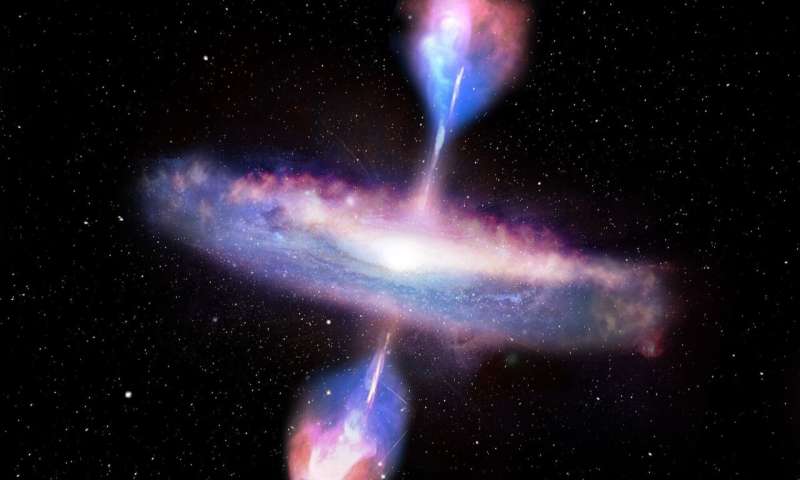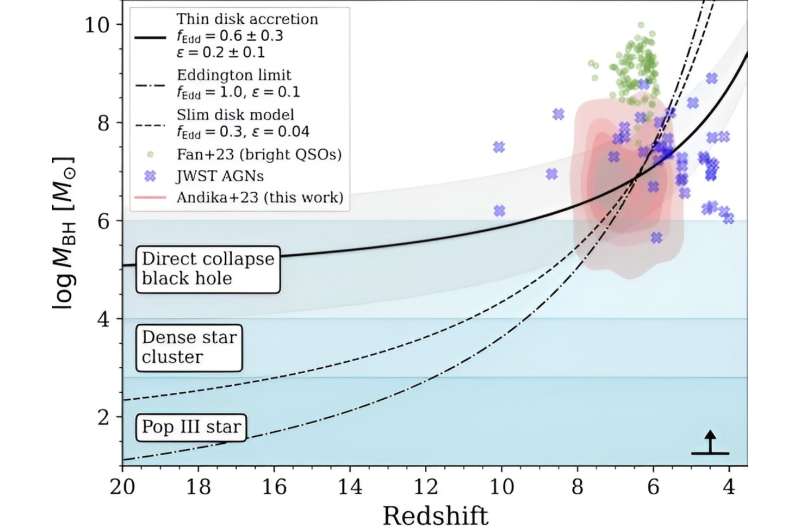This article has been reviewed according to Science X's editorial process and policies. Editors have highlighted the following attributes while ensuring the content's credibility:
fact-checked
preprint
trusted source
proofread
Webb sees dozens of young quasars in the first billion years of the universe

Within almost every galaxy is a supermassive black hole. Millions, sometimes billions of solar masses are locked within an event horizon of space and time. They can power luminous quasars, drive star formation, and change the evolution of a galaxy. Because of their size and abundance, supermassive black holes must have formed early in cosmic history. But how early is still an unanswered question. It's a focus of a recent study on the arXiv preprint server.
The team focused on distant quasars. Since the luminosity of a black hole depends in part on the size of the black hole, it can be used as a way to gauge the mass of early supermassive black holes. While quasars are fairly common in the early universe, the team wanted to study the most distant quasars, which can appear quite faint to us. So they drew upon several JWST sky surveys, including COSMOS-Web, JADES, UNCOVER, CEERS, and PRIMER.
From these surveys, they identified 350 compact galaxies with a redshift greater than z = 6. The light from these galaxies began their journey to Earth when the universe was less than a billion years old, making them among the earliest galaxies. Of these, 64 of them appeared to have quasars, indicating the presence of an active supermassive black hole. They then compared the luminosity and redshift to determine the age and mass of the black holes. A sample of 64 isn't huge, but it is enough for the team to apply Monte Carlo simulations to determine how the black holes evolved.

They found that statistically, these early supermassive black holes were large compared to their galaxies, having a mass of up to 10 million solar masses, compared to a galactic mass of a few billion suns. This ratio is higher than that of the local universe, which suggests that the black holes form early when their galaxy is small, rather than later when the galaxy is larger and more evolved. This supports the direct collapse model of supermassive black holes rather than the idea that they grow in mass through the merger of smaller black holes.
The authors do note that there is a bit of observational bias in their data. Because of the limits of observation, we are more likely to see more luminous and therefore more massive early black holes. So while this study shows that at least some early supermassive black holes formed by direct collapse, that doesn't mean all of them did.
But more deep sky surveys are in the pipeline, and with more data we will have more early black holes to study. Right now we know of dozens of early supermassive black holes. As that grows to hundreds we should be able to understand the various origins of galactic black holes.
More information: Irham T. Andika et al, Tracing the rise of supermassive black holes: A panchromatic search for faint, unobscured quasars at z > 6 with COSMOS-Web and other surveys, arXiv (2024). DOI: 10.48550/arxiv.2401.11826
Journal information: arXiv
Provided by Universe Today




















